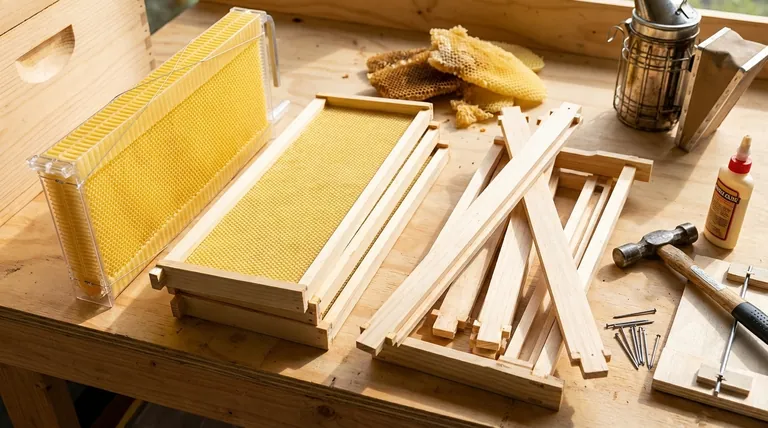Ultimately, the choice between assembled and unassembled frames is a direct trade-off between your time and your budget. Assembled frames offer immediate, out-of-the-box convenience, allowing you to place them directly into a hive. Unassembled frames require a significant time investment for construction but provide substantial cost savings, especially at scale.
While assembled frames save you hours of labor upfront, the time spent building unassembled frames is an investment in lower costs and greater control over structural quality. Your decision should be based on the scale of your operation and the value you place on your own time.

Quantifying the Time Investment
The primary difference is the manual labor required. Assembled frames are ready to use, while unassembled frames are a kit of wooden parts that you must build.
The Core Task: Nailing and Gluing
Each unassembled frame requires careful construction. This typically involves using one or two nails in each of the four corners, totaling up to eight nails per frame.
For a standard 10-frame hive box, this means driving up to 80 nails. If you are preparing three new boxes, you are looking at nearly 240 nails, plus the time to handle each individual piece.
The Importance of Precision
This process is not just about speed; it is about quality. Each frame must be built perfectly square and rigid.
A frame that is not square can disrupt the critical "bee space" within the hive, leading to unwanted comb construction. More importantly, a poorly nailed frame can fail under load.
The Weight of Success
A single frame fully laden with honey can weigh around 8 pounds. This weight demands a robust structure, which is why taking the time to nail each corner firmly—often supplemented with wood glue for maximum strength—is non-negotiable.
Assembled vs. Unassembled: Beyond Time
While time is the most obvious factor, the "why" behind choosing one over the other involves cost and quality control. The time you spend is directly exchanged for other benefits.
The Advantage of Assembled: Convenience
Assembled frames are a convenience product. The cost of labor is built into the price, but they eliminate the entire construction process.
This is especially valuable for beginners who may be overwhelmed with other tasks, or for any beekeeper who needs to expand a hive quickly.
The Advantage of Unassembled: Cost and Control
The main driver for choosing unassembled frames is cost-effectiveness. You are essentially paying with your time instead of your money.
Furthermore, building the frames yourself gives you complete control over the build quality. You can ensure every joint is glued and every nail is perfectly placed, potentially creating a more durable frame than some mass-produced assembled options.
Understanding the Trade-offs
Making an informed decision requires acknowledging the downsides of each choice. There is no single "best" answer, only the best fit for your situation.
The Hidden Cost of "Ready-to-Use"
Assembled frames are significantly more expensive. While this may be negligible for a single frame, the cost difference becomes substantial when establishing multiple new hives.
The Risk of Rushed Assembly
The biggest pitfall with unassembled frames is rushing the job. A weak or poorly constructed frame can collapse inside the hive, creating a disastrous mess of honey and broken comb that is difficult for both you and the bees to manage.
The time saved by working carelessly is not worth the risk of catastrophic frame failure.
Making the Right Choice for Your Goal
Your decision should align with your primary objective as a beekeeper.
- If your primary focus is speed and convenience: Choose assembled frames. This allows you to get your hives operational immediately, which is ideal for new beekeepers or emergency expansions.
- If your primary focus is minimizing cost: Choose unassembled frames. The money saved is significant, especially if you are managing several hives and have the time to invest in labor.
- If your primary focus is maximum durability and quality control: Choose unassembled frames. Building them yourself with glue and precise nailing ensures each frame is strong enough to last for many seasons.
By understanding this fundamental balance between time, cost, and quality, you can make the strategic choice that best supports your beekeeping operation.
Summary Table:
| Frame Type | Time Investment | Cost | Quality Control | Best For |
|---|---|---|---|---|
| Assembled | Minimal (Ready-to-use) | Higher | Standardized | Beginners, Quick Expansions |
| Unassembled | Significant (DIY Labor) | Lower | High (Customizable) | Cost-Sensitive, Large-Scale Apiaries |
Ready to optimize your apiary's efficiency and budget? The choice between assembled and unassembled frames directly impacts your operation's bottom line. For commercial apiaries and beekeeping equipment distributors, the right supplies are crucial for success. HONESTBEE supplies high-quality, durable beekeeping frames and equipment through wholesale-focused operations, ensuring you get the best value—whether you prioritize time-saving convenience or cost-effective DIY solutions. Let us help you make the strategic choice for your scale. Contact HONESTBEE today to discuss your wholesale needs and strengthen your operation.
Visual Guide

Related Products
- 7 x Auto Bee Flow Hive Frames Plastic Beekeeping Hive Box Supplies
- Professional Frame Comb Fork and Lifter for Efficient Handling
- Automatic Honey Flow Beehive 4 Frame Mini Hive for Beekeeping
- JZBZ Langstroth Queen Rearing Frame for Beekeeping
- Professional Bee Frame Wiring Tool with Integrated Tensioning System by HONESTBEE
People Also Ask
- What is the selling point of the Flow Hive? A Revolutionary, Stress-Free Honey Harvest
- How to extract honey in Flow Hives? Experience the Simplicity of Honey on Tap
- What are Flow Frames and how do they work? A Gentle Way to Harvest Honey
- What are the components of a hive frame? A Guide to Better Hive Management
- How do you clean plastic frames? A Gentle Guide to Preserving Your Frames



















